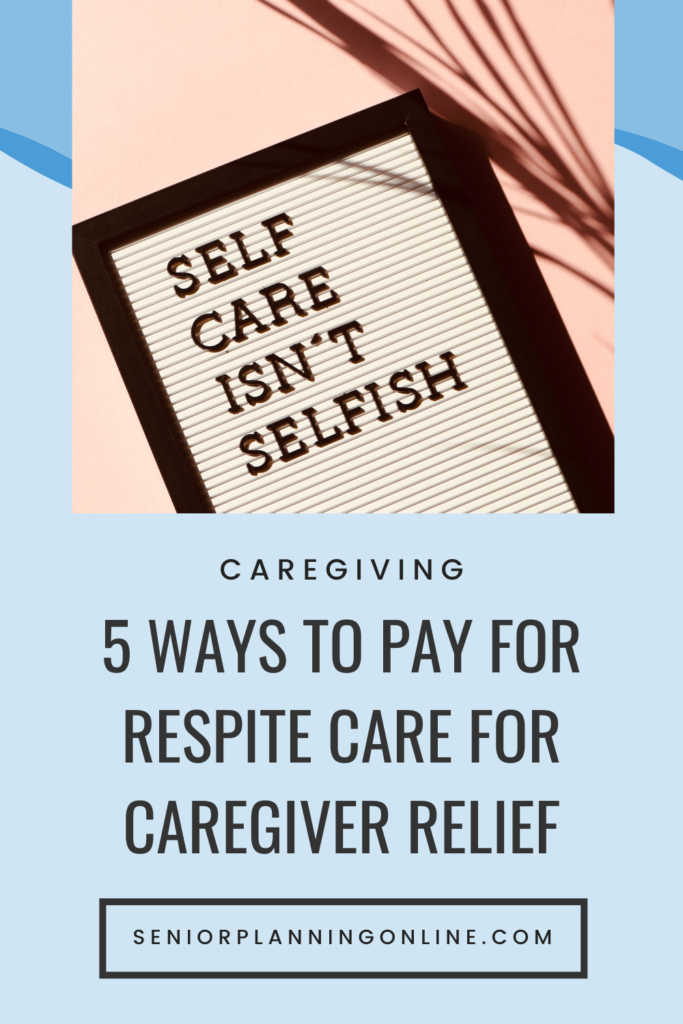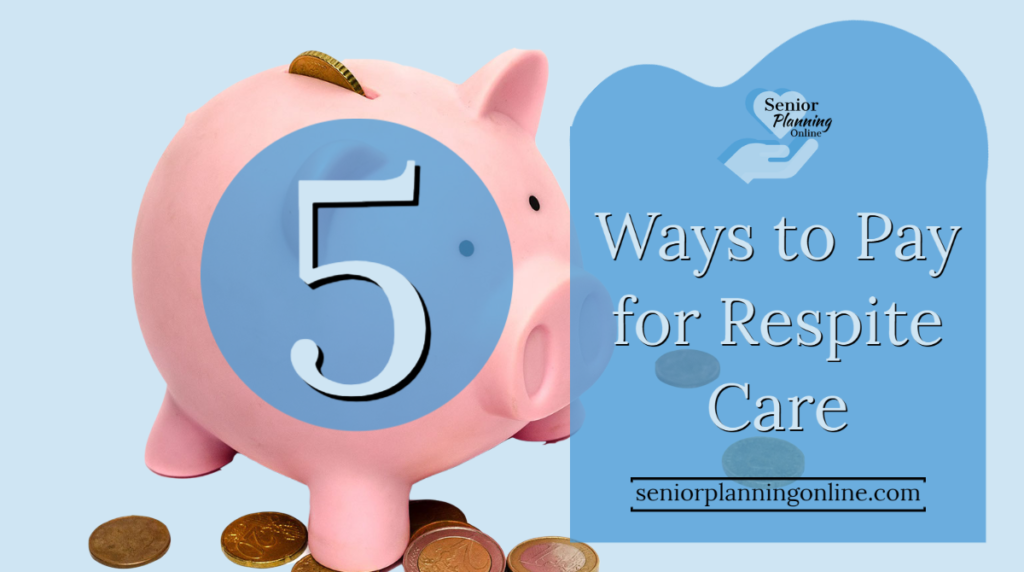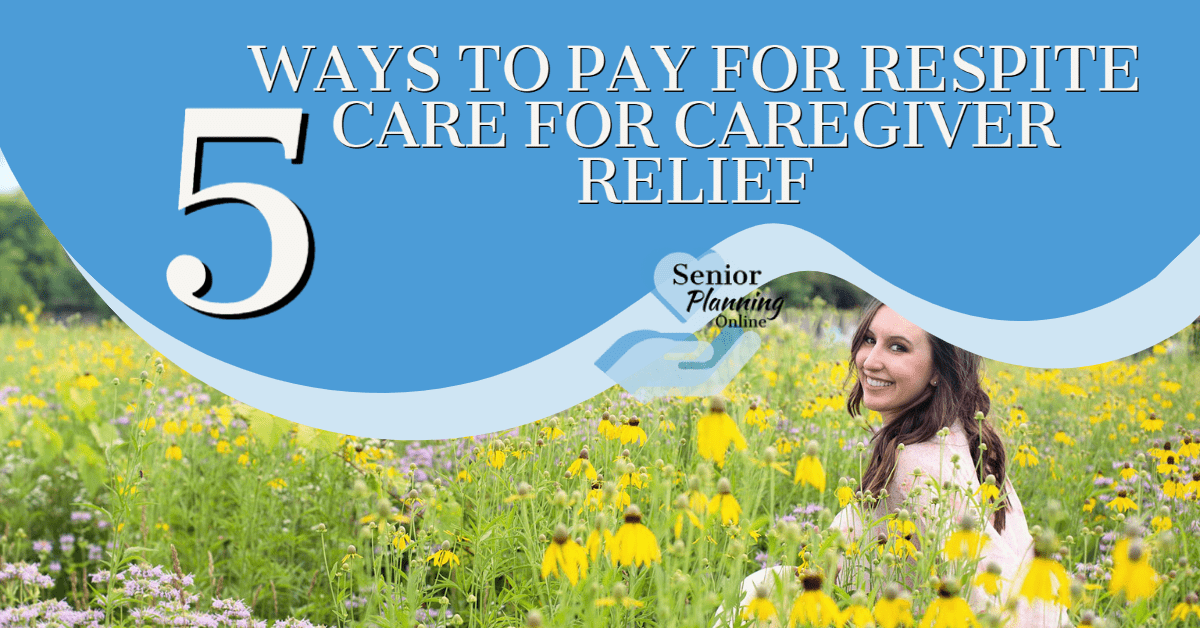If you are a caregiver, taking breaks are extremely important. Breaks are not only important for a caregiver’s mental and physical well-being, but also important for the health of the care receiver. One of the ways you can take breaks is through Respite Care.

In this post I will cover what respite care is, the types of respite care available and 5 ways to pay for respite care.
What is Respite Care?
The word respite means a short period or temporary time of relief from something challenging. Respite care provides short term relief to caregivers. Respite care can be for a few hours, several days or a few weeks. It can be provided in 3 main types of care discussed below.
Types of Respite Care
In-Home Respite Care
Many people prefer to have a caregiver come into the home and care for the care receiver, to give the primary caretaker a break. Sometimes people ask a friend or family member to come over for a few hours to provide some temporary relief to the caregiver.
If this isn’t an option, you can hire a professional caregiver to come into the home for a few to several hours at a time. You can find professional caregivers through private homecare agencies or by looking online like through caring.com.
While someone else is “watching” or caring for your loved one for a few hours, you can take this time to run errands or care for yourself. Check out some tips to relieve stress on our post “6 Tips to Prevent Caregiver Burnout”.
Most of the time In-Home respite care does not provide 24/7 caregiver services. It’s meant to provide temporary relief.
Senior Living Facility
A popular option for respite care is utilizing a care facility like an assisted living facility or a nursing home. Not all facilities offer this as an option, but there are a handful that do.
You can arrange for the facility to take your loved one for a few to several days at a time, to give yourself a break.
The facilities will provide a room (sometimes semi-private) with a medical bed, linens, and toiletries. They have nursing staff that will administer their medications at the correct times. They will also be served 3 meals a day plus snacks. And there are various activities they can participate in throughout the day.
Check out our post on “15 Questions to Ask a Skilled Nursing Facility” as a guide to help you pick the best facility to fit your loved one’s needs.
Adult Day Program
Another great option (and often underutilized) is taking your loved one to an adult day program.
An adult day program is either facilitated at a residential home or a community building. They are staffed with people who are trained in personal caregiving, dementia and nursing care.
Essentially it is providing similar benefits as a nursing home but without them having to stay there overnight.
It’s an excellent opportunity for them to socialize, receive the care they need and keep them engaged both mentally and physically.
Sometimes Adult Day programs will offer a transport system to pick up participants from their home to bring them to the program. If the Adult Day program does not offer this, you will likely need to drop them off and pick them up.
Hours of operation vary depending on the program but typically you will see them offer hours between 7am to 7pm Monday through Friday. Sometimes they offer weekend hours.
You can check out Adultdaycare.org to find available adult day programs in your area.

5 Ways to Pay for Respite Care
Unfortunately taking a break and getting relief doesn’t typically come free. There are costs involved. However, there are a few ways you can pay for respite care. Here are 5 ways to pay for respite care.
1. Private Pay (Out of Pocket)
If you have the financial means to pay for any of these options, you definitely are able to take more breaks. Most In-home respite care is paid for by the caregiver’s personal funds.
In-home care can run about $20-$30 per hour.
Facility respite care can run between $150 to $300 per day.
Adult Day care may be the most bang for your buck, it can run between $50-$75 per day.
2. Long Term Care Insurance
If your loved one has a long term care insurance policy, that insurance company may help with the adult day care expenses. Check the policy to see what it includes. It might include a set amount of hours for in-home care or a certain amount allocated for facility respite care.
3. VA Benefits
If your loved one is a Veteran, they may be eligible to receive financial assistance or additional care through the VA. The VA offers adult day program services or financial assistance to hire a caregiver into the home.
You can find information about these services through your local VA caregiver support program or check out the Hidden Heroes program.
TIP: if you are looking to get financial assistance to pay for in-home caregiving, ask your local VA about the Aid and Attendance program. If the Veteran is eligible for the Aid and Attendance program, the Veteran can get a stipend that is used to pay for care at home or even in the community. You can find the application for this program here.
4. Medicaid Home and Community Based Services
If your loved one is low-income and requires assistance at home, they can receive additional care in the home through this Medicaid waiver.
Check our post “7 Services Through Medicaid to Help Seniors Stay Independent“ to see what services are provided and how to apply for this program.
Depending on what state you live in, Medicaid can pay up to 42 days per calendar year for facility respite care as well. Check out your State’s Medicaid program for the details
5. Medicare Benefits
People get confused about Medicare and Medicaid benefits all of the time. Please check out our post ”The Difference Between Medicare and Medicaid” for clarification on how each program is different and what services they provide.
Medicare ONLY pays for respite care through Hospice. Hospice is paid for by Medicare part A services.
Essentially the Hospice company receives a lump payment from Medicare to help care for your loved one and provide comfort care services. Hospice companies are supposed to use that lump sum to pay their staff and to help pay for any additional care your loved one needs to remain comfortable through their end of life stages.
This often includes respite care at a facility. Most of the time, hospice will pay for up to 5 days at a time every 30-60 days for your loved one to stay at a nursing facility for care.
However, every hospice company works a little differently and not all hospice companies are contracted with all nursing facilities to provide respite care.
It’s also important to note that if your loved one is receiving Palliative care, NOT hospice care, they won’t qualify for respite care to be paid for by that company. Palliative care companies do not get paid the same way as hospice companies through Medicare. So they do not have the ability to pay for respite care.
Why You Should Consider Respite Care
Respite Care is a great way to prevent caregiver burnout. It can help keep your sanity, give you time to care for yourself and ensure the care and safety of the care receiver.
If you still feel you can handle caring for your loved at home, and feel that you can maintain their safety and quality care, you should consider respite care. It is important to come up with a plan BEFORE you find yourself overwhelmed and headed towards burnout.
If you aren’t sure if you are stressed or have burnout, take our quiz: Caregiver Burnout Quiz
Respite care can be a great addition to your loved one’s plan of care and ensuring your own health stays intact!
The Bottom Line
If you are not ready to send your loved one to a senior living community, respite care can be a great alternative. It provides short term relief for the caregiver so that they can take care of their own needs and hit the refresh button.
You can use in-home care, a facility or an adult day program for respite care options.
Unfortunately it is not a free service but there are other ways you can pay for respite care outside of using your own funds.
There are options through long term care insurance if your loved one has it, the VA, Medicaid and Hospice through Medicare.
As a caregiver, taking breaks is necessary for the health of the caregiver and especially for the health of the one you are caring for. If you aren’t around to care for them due to health issues, who will take care of them? Take care of yourself!


No responses yet